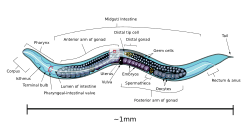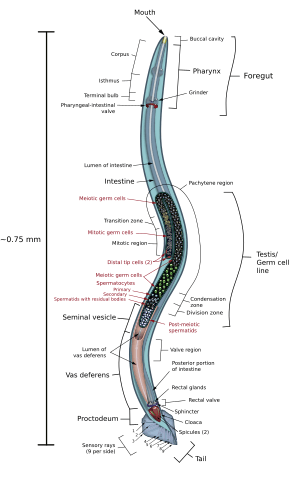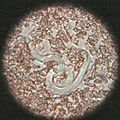Nematode facts for kids
Quick facts for kids Nematodes |
|
|---|---|
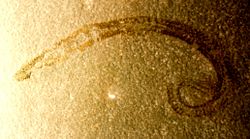 |
|
| Eophasma jurasicum, a fossilized nematode | |
| Scientific classification | |
| Kingdom: | |
| Subkingdom: | |
| (unranked): | |
| Phylum: |
Nematoda
Rudolphi, 1808
|
Nematodes, also known as roundworms, are a very diverse group of animals. They are part of the protostome family of animals. There are over 80,000 known types of nematodes, and more than 15,000 of these live as parasites. Scientists believe there could be over 500,000 different kinds of roundworms in total, including those not yet discovered.
Contents
What are Nematodes Like?
Nematodes are usually small, thin worms. They are often about 5 to 100 micrometers thick and 0.1 to 2.5 millimeters long. The smallest ones are so tiny you need a microscope to see them. Some free-living nematodes can grow up to 5 centimeters (2 inches) long. But some parasitic types can be even bigger, reaching over 1 meter (3 feet) in length! Their bodies often have ridges, rings, or tiny bristles.
Their Head and Body
A nematode's head is quite special. While the rest of its body is symmetrical (meaning it's the same on both sides), its head is radially symmetrical. This means it's like a circle, with sensory bristles and 'head-shields' spreading out around its mouth. The mouth usually has three or six lips, which sometimes have small teeth. Many nematodes also have a sticky gland at the tip of their tail.
The outer layer of their body, called the epidermis, is covered by a thick, tough skin called a collagenous cuticle. This cuticle is often very complex. Underneath the epidermis are long muscle cells. The stiff cuticle and these muscles work together to form a "hydroskeleton," which helps the worm move. This is because nematodes do not have muscles that go around their body. A unique thing about nematodes is that their muscle cells send parts to their nerve cords, instead of the other way around.
How Nematodes Eat
The mouth area of a nematode is lined with the tough cuticle. This lining can have ridges or other structures. In nematodes that eat meat, it might even have teeth. Many nematodes have a sharp, hollow spike called a stylet. They can push this stylet into their prey to suck out liquids, especially from plants or other animals.
The mouth leads to a strong, sucking tube called a pharynx. This tube is also lined with cuticle. The pharynx has glands that make enzymes to start breaking down food. If a nematode has a stylet, these enzymes might even be injected into its prey.
Nematodes do not have a stomach. The pharynx connects directly to a long intestine that makes up most of their gut. The intestine produces more enzymes and takes in nutrients through its thin lining. The last part of the intestine is also lined with cuticle and is called the rectum. Waste leaves the body through the anus, which is near the tail. Food moves through the digestive system as the worm moves its body. The intestine has special valves at each end to help control food movement.
How Nematodes Get Rid of Waste
Nematodes get rid of waste like ammonia through their body wall. They don't have special organs for this. However, they do have more complex systems to get rid of salt and keep their body fluids balanced (this is called osmoregulation).
Many ocean nematodes have one or two special cells called 'renette glands'. These glands release salt through a small hole near the pharynx. In most other nematodes, these cells are replaced by a system of two parallel tubes connected by a cross-tube. This cross-tube opens into a common canal that leads to the excretory pore.
Their Nervous System
Nematodes have four main nerves that run along their body: one on the top (dorsal), one on the bottom (ventral), and two on the sides (lateral). Each nerve is inside a cord of tissue under the cuticle and between the muscle cells. The ventral nerve is the biggest. The dorsal nerve controls movement, the lateral nerves are for sensing, and the ventral nerve does both.
The nervous system is the only place in a nematode's body that has cilia. These are tiny, non-moving hairs that help with sensing.
At the front of the worm, the nerves branch out from a thick, circular nerve ring that surrounds the pharynx. This nerve ring acts like the nematode's brain. Smaller nerves go forward from this ring to the sensory organs in the head.
Nematodes have many sensory bristles and papillae on their bodies that help them feel things. Behind the sensory bristles on their head are two small pits called 'amphids'. These pits have many nerve cells and likely help the nematode smell or taste chemicals in its environment. Some water-dwelling nematodes have what look like eye-spots, but it's not clear if they can actually see.
Nematodes as Parasites
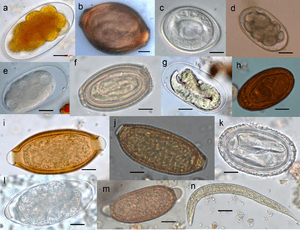
Many nematodes are parasites, meaning they live on or in other living things and get their food from them. Some common nematodes that can infect humans include ascarids, filarias, hookworms, pinworms, and whipworms.
The Trichinella spiralis worm, also called the 'trichina worm', can be found in rats, pigs, bears, and humans. It causes a disease called trichinosis. Baylisascaris usually infects wild animals, but it can be very dangerous for humans. Dirofilaria immitis causes heartworm disease in dogs and some cats, living in their hearts, arteries, and lungs. Haemonchus contortus is a very common parasite in sheep worldwide, causing big problems for farmers.
On the other hand, some nematodes are good for humans! These are called entomopathogenic nematodes, and they are parasites of insects. Farmers often use them to control harmful insect pests.
One type of nematode depends entirely on fig wasps. These wasps are the only way fig trees can be fertilized. The nematodes prey on the wasps, riding them from the ripe fig where the wasp was born to the fig flower where the wasp dies. There, the nematodes kill the wasp, and their babies wait for the next generation of wasps to be born as the fig ripens.

Nematodes that parasitize plants can cause serious damage to crops. For example, the pine wood nematode (Bursaphelenchus xylophilus) attacks bark and forest trees. It is found in Asia, America, and recently in Europe.
Nematodes in Farming and Gardening
Nematodes can be either helpful or harmful to plants. In farming and horticulture (gardening), there are two main types:
- Helpful nematodes: These are predators that kill garden pests like cutworms and corn earworm moths. You can even buy them as a natural way to control pests.
- Harmful nematodes: These are pests themselves, like the root-knot nematode, which attacks plants. Some nematodes also act as vectors, spreading plant viruses between crop plants.
Farmers use different methods to manage harmful nematodes. One way is to plant crops that are resistant to nematodes, or to rotate crops with plants like marigolds. Growing marigolds for one or more seasons can help control nematodes in the soil. Another method is to use natural enemies of nematodes, such as the fungus Gliocladium roseum.
Chitosan, a natural substance, can help plants fight off parasitic cyst nematodes on the roots of soybean, corn, sugar beet, potato, and tomato plants. It does this without harming the helpful nematodes in the soil. Steaming the soil is another effective way to kill nematodes before planting, but it kills both good and bad soil creatures.
The golden nematode (Globodera rostochiensis) is a very damaging nematode pest that has caused crop failures and quarantines around the world. Scientists have found that using Indian mustard as a green manure or seed meal in the soil can greatly reduce the number of these nematodes.
Related pages
Images for kids
See also
 In Spanish: Nematoda para niños
In Spanish: Nematoda para niños


